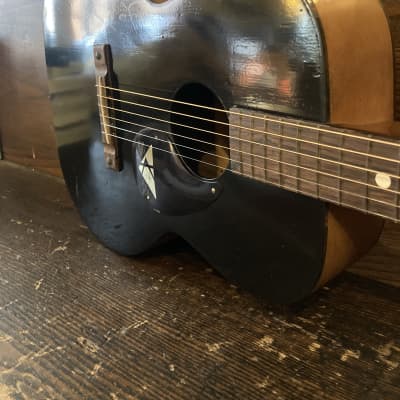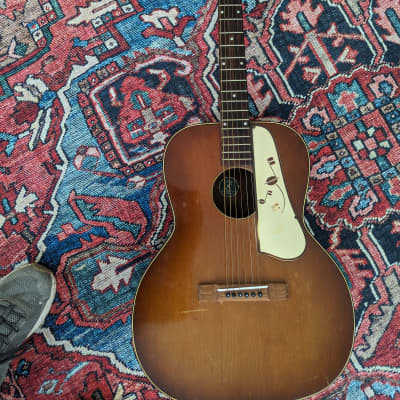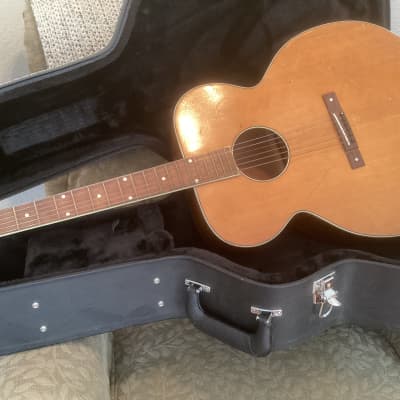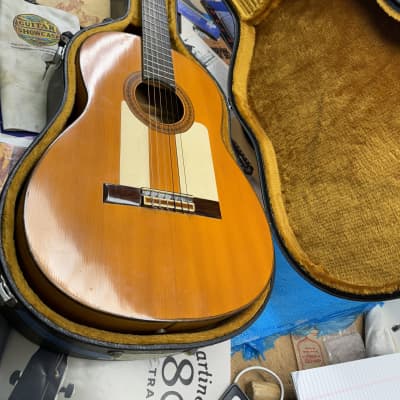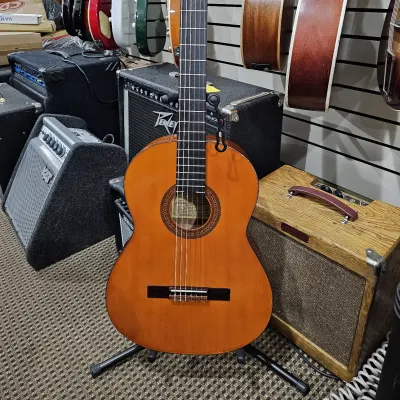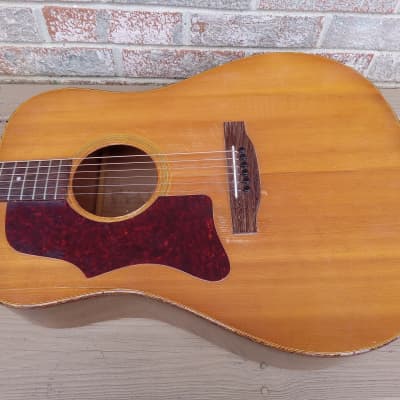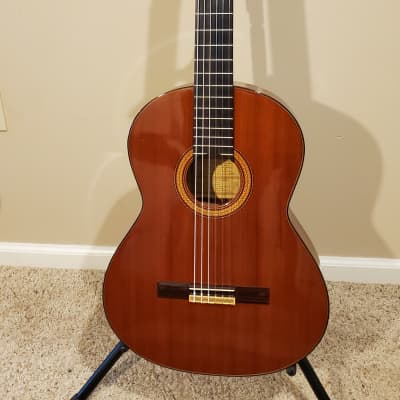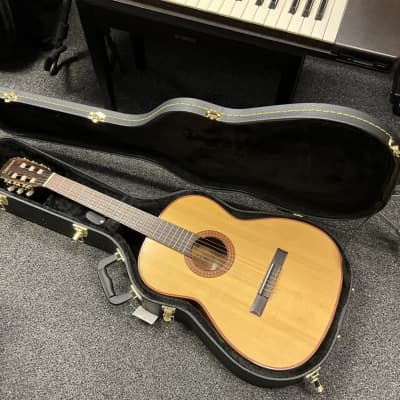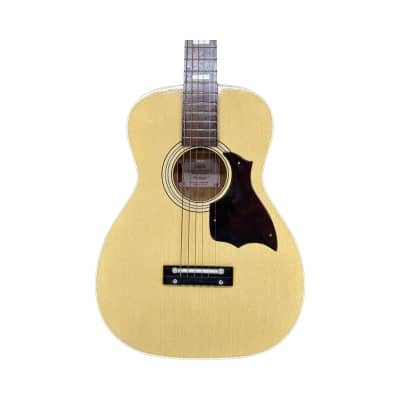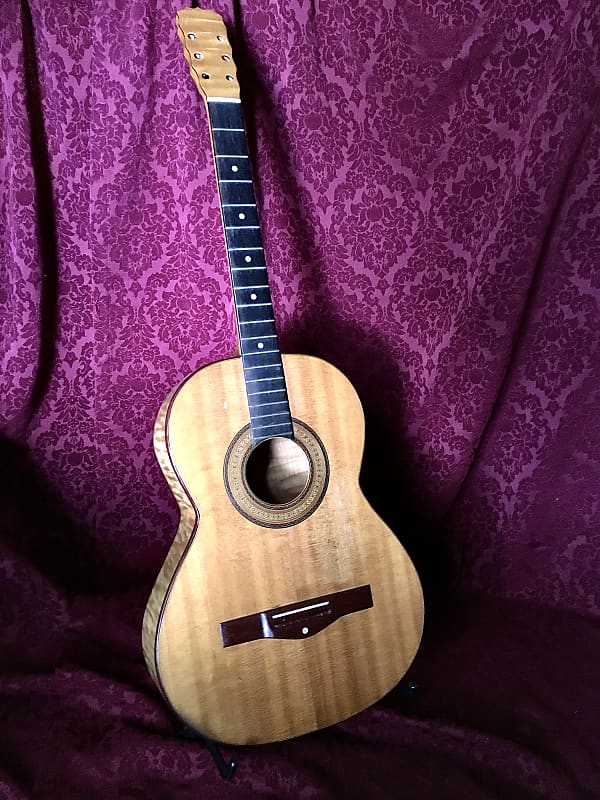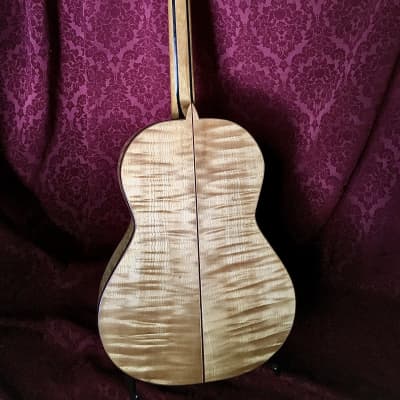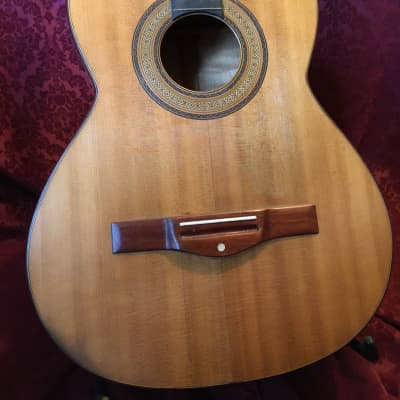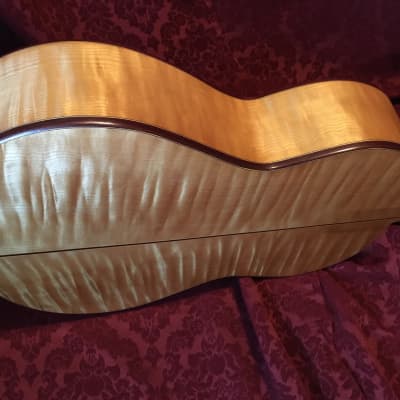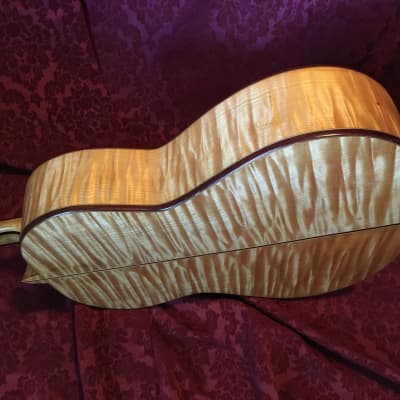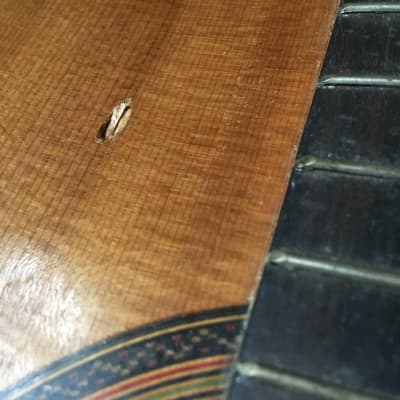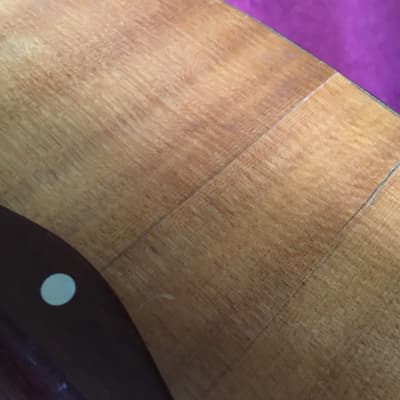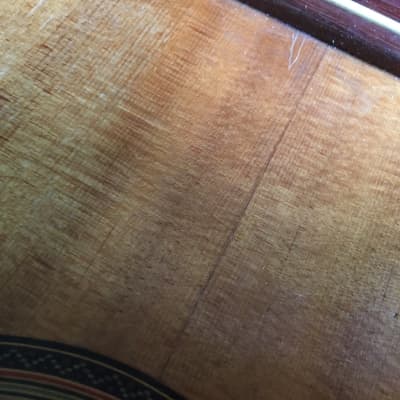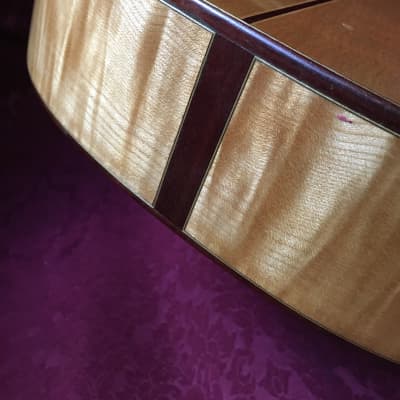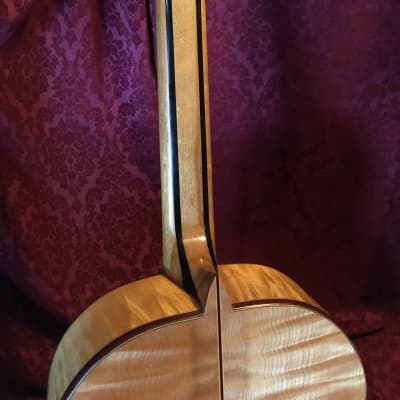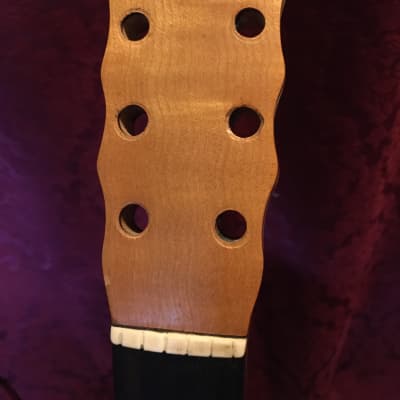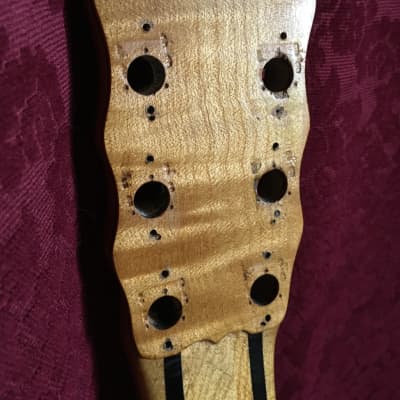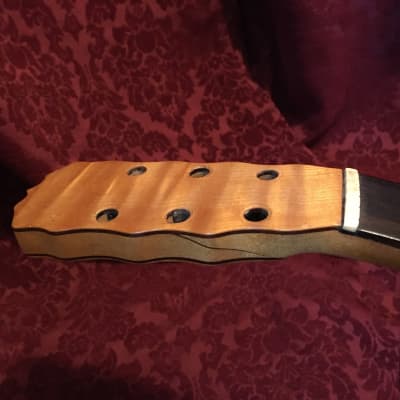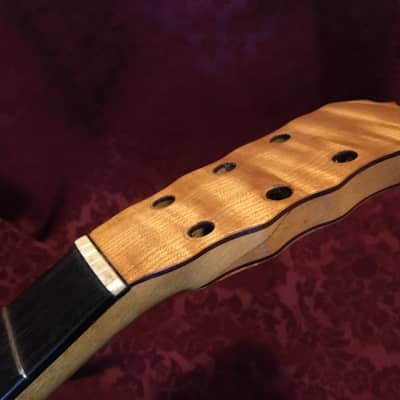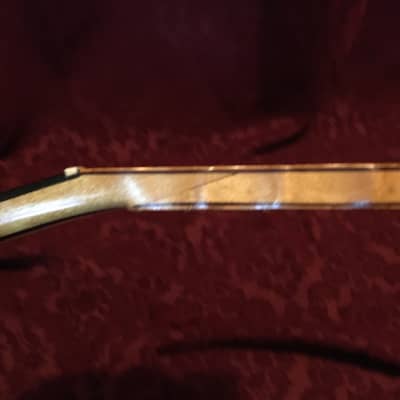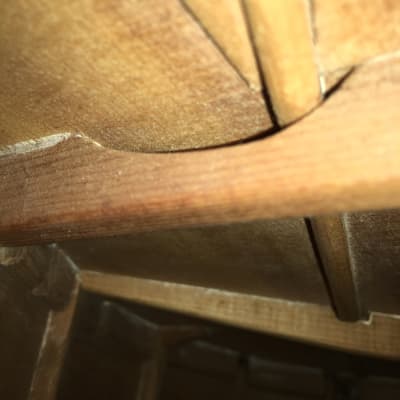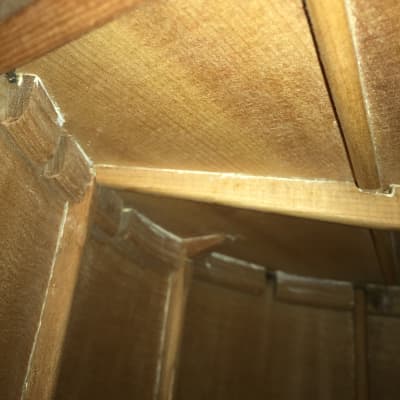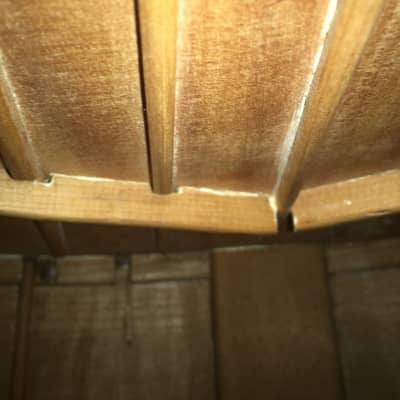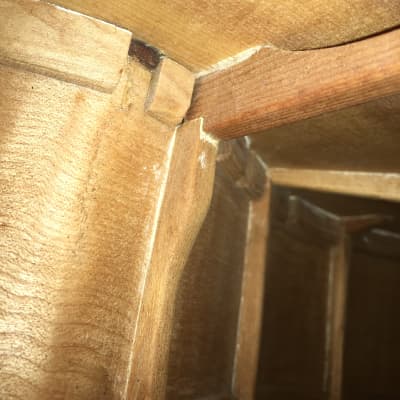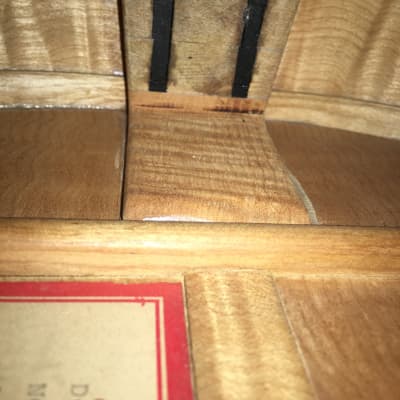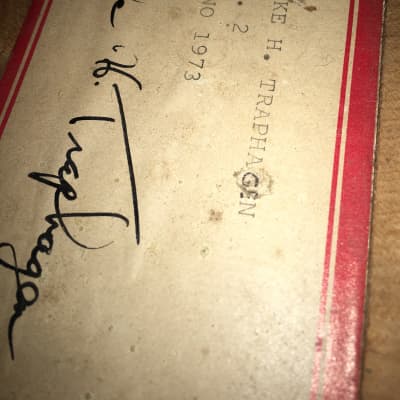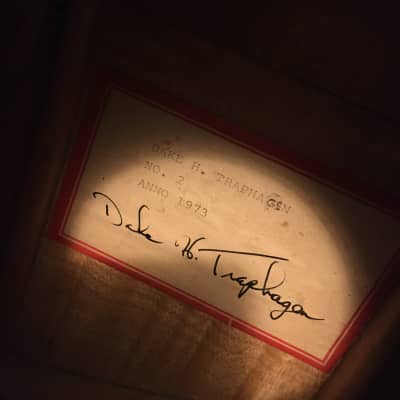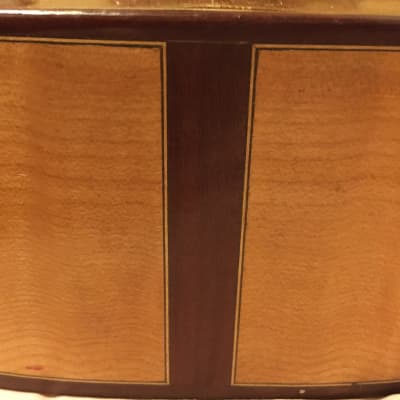Throughout my 40 years of being a full time repair person I have amassed more interesting instruments to restore than I likely have years left to complete them.It is in the sober light of that realization that I offer this worthy guitar. There were some innovative guitars being built by individual makers throughout the1970's.This early work of Dake Traphagen is a great example of not only that era of experimentation but also how good his skills were,even at the start of his career.The solid Maple Back & Sides show a deep broad curly figuring.18-3/4"body length,14-3/8"lower bout width,10-5/8"upper bout width,3-3/16"body depth@the neck block,3-15/16"@the end block.Solid Spruce(Sitka perhaps)3-5/16"diameter soundhole.There is an open hairline crack along each side of the fingerboard and another appx.4"long crack behind the bass side of the bridge.The center seam also appears to be open a bit,but it maybe just how the seam has reacted over the years because there is a fan brace glued along it's length on the underside and it seems to still be tight.I tried to show the cracks as well as a small dent in the upper bass side bout of the top in the pictures.Other than these relatively minor top cracks,there is no evidence of any previous cracks in the back or sides.The set of Maple he used is beautiful,having prominent figuring throughout and almost no mineral streaks,sap pockets,knot shadows or flaws of any note.I'm not sure if the finish is lacquer or french polish or maybe lacquer on the b/s and fp on the top.Whatever the finish is,it is well done and not thick. It highlights the depth of the Maple's curl with a nice low luster sheen.It does show signs of it's 48 years of use and wear,but it will likely polish up nicely though I have done no cleaning,leaving the patina intact.In fact I have done no work to it at all though I certainly intended to.It had light gauge steel strings on it when I got it about 30 years ago.Juding by the footprint/holes it likely had Schaller M-6's originally.There was a set of inexpensive tuners that I removed and no tuners are included.Although the neck shaft was pretty straight it had high action due to poor neck angle.The high action limited playing to the open position,but the tone was full and clear with surprising volume.I dont recall that there was any collapse or caving in the top around the soundhole,nor was there any failures or looseness in the neck/body joint which is a variation of a classical heel/neck block/foot arrangement.All this structure seems to be tight and as intended.Given the stable/intact nature of the neck/body joint,what seemed to be a potentially sensible approach(and my intended plan of action)would be to pull the frets and plane the -already on the thin side-Ebony fingerboard down so that it's basically a flat veneer/lamination and then glue a new "ramped"fingerboard over it.This would seem to address several issues.As there is no adjustable truss rod,it would afford the opportunity to address any existing relief issues,bolster structural integrity,restore playability,maintain originality and allow the new fingerboard wood selection to more closely match the bridge & bindings,which appear to Vermillion/Padouk or some type of reddish tropical hardwood.The scale length is appx.25.5".
However the neck angle issue is handled,it represents the majority of the required restoration work.Overall the guitar is in very good condition.The neck is made of 3 pieces of fine grained hard Maple with 2-1/4"w x 1/2"t bars of what appears to be Ebony.It's possible they're made of some sort of composite/mastic material,but I'm guessing Ebony.They extend from the top of the scarfed peghead(which is interestingly reminiscent of guitars from17th century) straight through into the laminated headblock.The nut width is appx.1-11/16" and proceeds to taper only slightly to appx.2" where neck meets the body at the 12th fret.The back profile of the neck is almost square with only the slightest rounding of the"hips"of the neck's edges around to the very flat back of the neck.It makes for an unusual feel-a straight taper and a square profile.Replacing the fingerboard would also present the chance to tweak the feel abit.
The really cool aspect of this guitar is the top bracing.This was seemingly designed to be used with steel strings or as a hybrid.The bracing pattern incorporates 5 fans and 2 what I'll call"Side Arm"braces which add support to the area behind the bridge.The center fan spans the center seam.There is one transverse brace appx.1/2" below the soundhole.It's a substantial 5/16"w x 5/8"t and has 2 underpasses that are appx.2"long & 1"in from the linings and allow the outside fans on the both the bass and treble sides to pass through right up to the edge of the soundhole.The fans are appx.3/16"x3/16".The 3 center fans butt up against the transverse brace and extend all the way down to the linings.The linings are a modified tentellone style.The side arm braces angle from the linings appx.2"below the waist descending and meeting butted up to the center fan just behind the bridge.Both of these 1/4"w x 1/2"t braces are notched as well to let the fans pass through.There are also 2 appx.1/4"w finger braces that sit atop the side reinforcing pedestal graphs that actually extend appx.1/2"onto the underside of the top.There is one on both the treble and bass sides at appx.the widest point of the lower bout.There are also 6 more side reinforcing graphs that support the ends of the 2 upper transverse face braces above the sound hole and the brace below the soundhole,and 2 more side graphs flanking the end block.The top has some slight rippling between the fans behind the bridge,but I dont recall the top being excessively domed or "bellied".The bridge is appx.8"long and it's wings intersect the outermost fans and the projecting side arm braces that meet beneath both the bass and treble sides.The bridge is a string through,back loading style.The saddle has almost no compensation angle.
All the wood working and joinery as well as the overall level of craftsmanship is very clean and professional.You can easily see the hand of this current master builder in his second instrument.Embodying the enthusiasm of the 1970's acoustic guitar renaissance it's a remarkable and historically significant instrument that's totally worthy of the work it requires.He still makes a model with similar dimensions -Model 00-to this guitar highlighting his continuing interest with the elegant blending of a Classical aesthetic into steel string design.I'm happy to provide any details I may have omitted.

